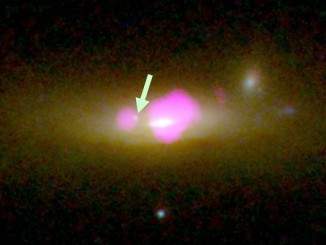
Astronomers have reconstructed a higher fidelity, much sharper image of the supermassive black hole at the heart of Messier 87 that was originally “photographed” by the Event Horizon Telescope collaboration.
Another team using the Hubble and Keck telescopes have come up with a 3D map of M87, showing the huge galaxy to be more potato shaped than perfectly spherical. Based on the new observations, they determined a more precise estimate of the mass of the central black hole imaged by EHT: 5.37 billion times that of the Sun.
The fiery ring around the shadow of the black hole’s event horizon in the iconic 2019 EHT image is now a factor of two narrower and almost fully symmetric, providing what amounts to a full-resolution view of the black hole, located some 55 million lightyears from Earth.
The machine learning technique – known as principal-component interferometric modelling, or PRIMO for short – was developed by EHT team members Lia Medeiros, Dimitrios Psaltis, Tod Lauer and Feryal Ozel and described in a paper published in The Astrophysical Journal Letters.
With PRIMO, “we were able to achieve the maximum resolution of the current array,” lead author Medeiros said in a release from NOIRLab, the National Optical-Infrared Astronomy Research Laboratory.
“Since we cannot study black holes up close, the detail in an image plays a critical role in our ability to understand its behaviour. The width of the ring in the image is now smaller by about a factor of two, which will be a powerful constraint for our theoretical models and tests of gravity.”
Just after the new black hole image was released, astronomers at the University of California at Berkeley announced results of a study showing M87 is shaped like a russet potato, with a short axis 72.2 percent the length of its long axis.
By using a new instrument on the Keck II telescope – the Keck Cosmic Web Imager – the team was able to measure the collective speeds of stars across the galaxy and thus the mass of the black hole they orbit.
“The Keck data are so good that we can measure the intrinsic shape of M87 along with the black hole at the same time,” said Chung-Pei Ma, a UC Berkeley professor who led the research. “We made the first measurement of the actual 3D shape of the galaxy.”

To reconstruct the EHT image, computers analysed more than 30,000 simulated images of gas falling onto a black hole to identify common patterns. The results were then blended together to create a much more accurate representation of the original EHT image, which was itself a blend of data from seven radio telescopes.
Medeiros’ team confirmed the reconstructed image is consistent with EHT data and matches theoretical predictions about the ring of emissions generated by hot gas falling into a supermassive black hole.
“PRIMO is a new approach to the difficult task of constructing images from EHT observations,” said Lauer. “It provides a way to compensate for the missing information about the object being observed, which is required to generate the image that would have been seen using a single gigantic radio telescope the size of the Earth.”
The NOIRLab release said the new image may lead to “more accurate determinations of the mass of the Messier 87 black hole and the physical parameters that determine its present appearance.”
“The data also provide an opportunity for researchers to place greater constraints on alternatives to the event horizon (based on the darker central brightness depression) and perform more robust tests of gravity (based on the narrower ring size).”
PRIMO may also be used to sharpen up the EHT image of Sagittarius A*, the black hole at the heart of the Milky Way.



